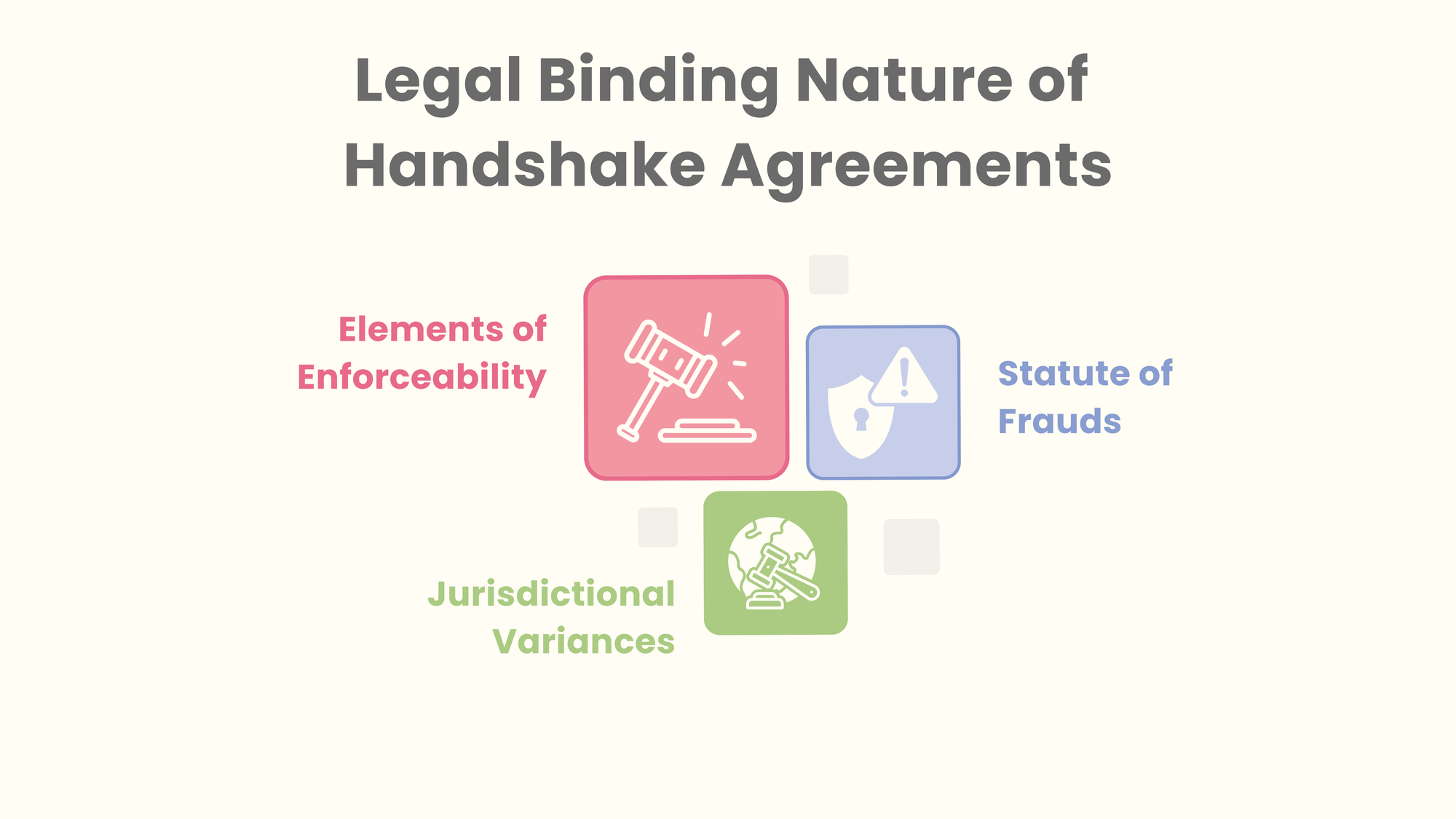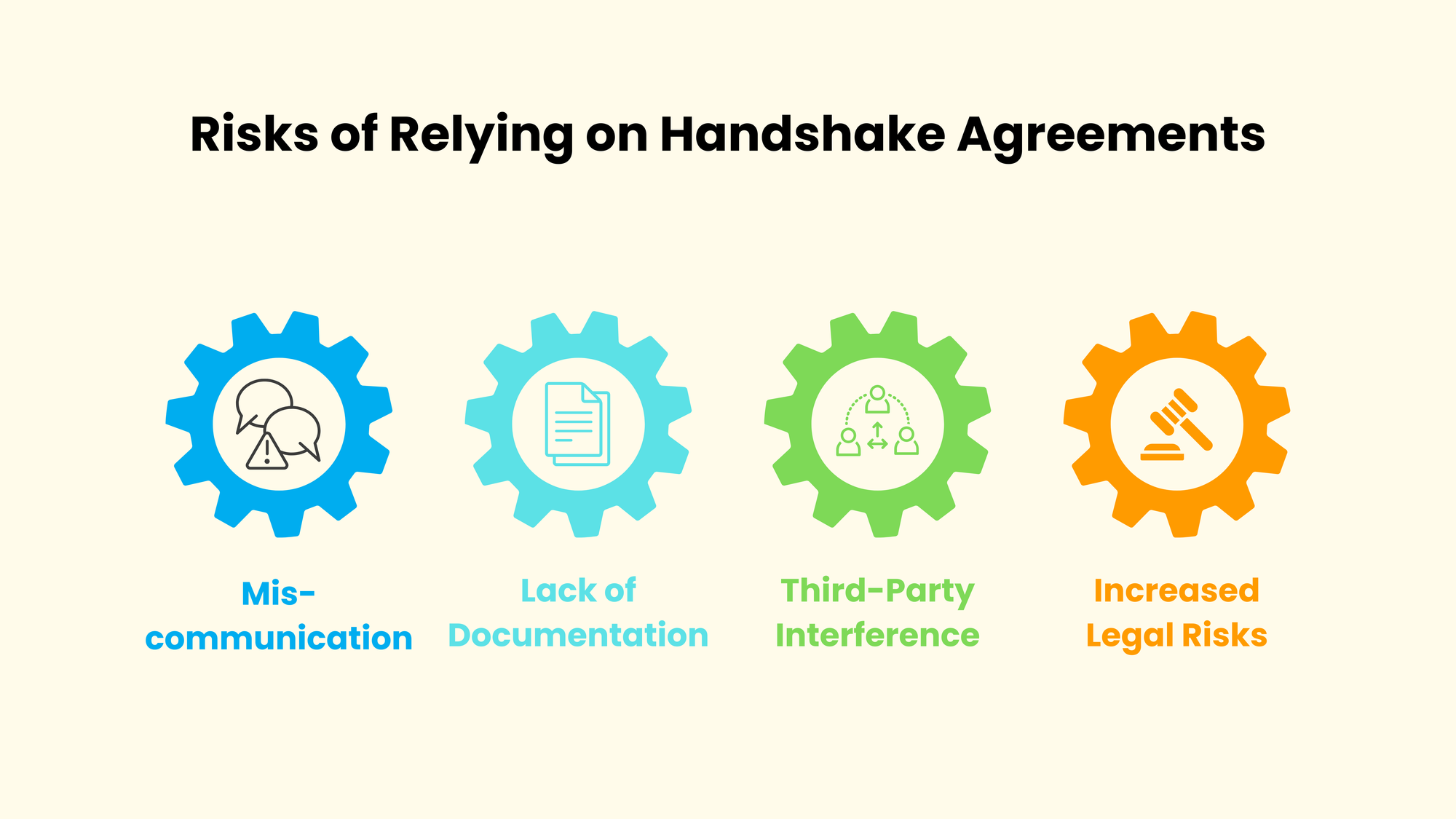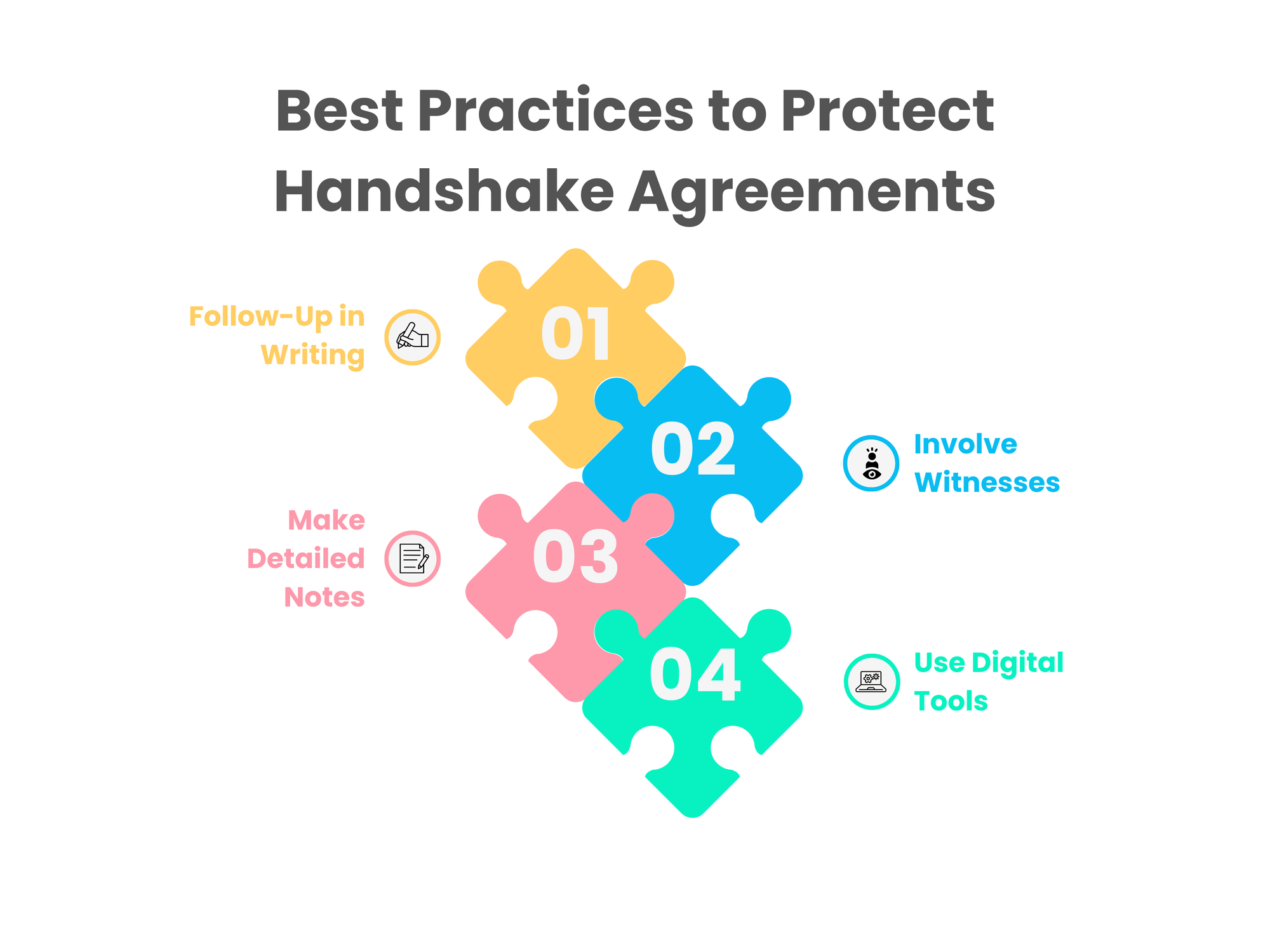A Guide to Handshake Agreements in B2B Transactions

Have you ever made a business deal on a handshake, trusting that the verbal agreement alone would stand? Many professionals have, especially in situations where trust and mutual respect are enough.
But does a handshake alone make the deal legally binding in the B2B transcations? Contrary to popular belief, handshake agreements indeed carry legal weight, even without written documentation.
This guide breaks down the circumstances under which a handshake agreement is legally enforceable, exploring both the advantages and risks of these informal deals in modern business contexts.
Table of Contents:
- What is a Handshake Agreement?
- Legal Binding Nature of Handshake Agreements
- Pros and Cons of Handshake Agreements in B2B
- Risks of Relying on Handshake Agreements
- How do Courts Treat Handshake Agreements?
- Best Practices to Protect Handshake Agreements in B2B
- When to Insist on a Written Contract?
- Alternatives and Supplementary Measures to Handshake Agreements
- Common Scenarios of Handshake Agreement Disputes
- Conclusion: Are Handshake Agreements Right for Your Business?
Jump to a section that interests you, or keep reading.
What is a Handshake Agreement?
A handshake agreement is an informal contract made through verbal communication and sealed with a handshake rather than with a signature on a written document. This type of agreement relies on spoken words to define the terms, with each party offering and accepting an exchange of value, known as "consideration," such as money, services, or other goods.
For instance, two businesses agree to a service exchange in which one party provides services to the other in return for compensation. But, the terms of the service exchange are purely verbal and are not formally recorded.
Handshake agreements are commonly seen in B2B transactions in various settings, such as small business partnerships, vendor agreements, or initial engagements before formal contract documentation. They occur when parties are building a new relationship or working on simple deals, and both sides feel confident in the informal arrangement based on mutual trust. Although a handshake agreement speeds up negotiations and builds rapport, its lack of formal protections introduces risks, particularly in cases of complex or high-value transactions.
Legal Binding Nature of Handshake Agreements

Elements of Enforceability
- Offer, Acceptance, and Consideration: Handshake agreements can be legally binding under contract law, but enforceability depends on meeting specific requirements. The fundamental components of a binding verbal contract are offer, acceptance, and consideration. An offer occurs when one party proposes an exchange, such as services for payment. Acceptance is the clear agreement to the offer, while consideration refers to the exchange of value between the parties, which could be money, services, or goods. Without these three elements, a handshake agreement lacks the legal foundation necessary to be enforceable.
- Intention to Create Legal Relations: Another important factor is the intention to create legal relations. Both parties must clearly intend for the handshake to be legally binding rather than a casual or non-binding arrangement. This intention to bind one another legally is a fundamental distinction between a simple social agreement and an enforceable business contract. If either party does not view the handshake as a legally binding commitment, the agreement will be invalid if disputed.
Statute of Frauds
Handshake agreements face limitations under the Statute of Frauds, which mandates that certain types of contracts must be in writing to be enforceable. For example, agreements involving real estate transactions, debt guarantees, and contracts that cannot be completed within a year are generally required to be in written form. These statutory requirements provide greater clarity and help prevent disputes over significant or complex agreements.
Jurisdictional Variances
The enforceability of handshake agreements varies by jurisdiction, with different regional legal frameworks affecting the treatment of verbal contracts. For instance, in the United States and the UK, general contract principles apply but include statutory exceptions that impact specific agreements. In Australia, verbal contracts are similarly recognized, but they must meet statutory requirements to be legally binding, such as the necessity for fairness in consumer contracts. Understanding these jurisdictional variances is important for businesses operating across regions, as it influences how handshake agreements are interpreted and enforced by courts in different locations.
Pros and Cons of Handshake Agreements in B2B
Handshake agreements in B2B contexts present both advantages and challenges, which makes them suitable for some situations while posing significant risks in others.
Pros of Handshake Agreements
One key advantage of handshake agreements is their flexibility and speed in sealing deals. Unlike formal written contracts, handshake agreements allow parties to come to terms quickly, which can simplify initial arrangements without the delays involved in contract review and drafting. This flexibility is particularly beneficial for simple deals or partnerships built on shared understanding.
Handshake agreements also help build trust and rapport, especially in longstanding partnerships. The informality of a handshake emphasizes trust, strengthening the personal bond between business partners and facilitating a cooperative atmosphere. This element of mutual respect is valuable in B2B relationships where maintaining ongoing goodwill is important. Furthermore, the less formal nature of handshake agreements contributes to an environment that feels more personal and engaged in creating authentic business relationships.
Cons of Handshake Agreements
However, handshake agreements come with serious drawbacks, particularly in terms of enforceability and the challenges of proving terms if disputes arise. With no written documentation, it becomes harder to demonstrate the specific terms agreed upon, which makes these agreements difficult to enforce in a legal setting. The reliance on memory and verbal confirmation creates ambiguities that lead to misunderstandings, which can erode trust and ultimately harm the business relationship.
In addition, handshake agreements bring a risk of financial loss if terms are disputed or misremembered. When financial stakes are high, any discrepancies in recalling terms such as deadlines, payment amounts, or specific deliverables can lead to costly litigation or lost revenue. Without written terms, businesses will also face unanticipated costs in attempting to resolve disputes or make up for unmet expectations, which makes handshake agreements risky, especially for complex or high-value transactions.
Risks of Relying on Handshake Agreements
Relying on handshake agreements introduces critical risks due to their informal, undocumented nature:

- Miscommunication: Without a written record, verbal agreements often lead to differing recollections of terms. Even small misunderstandings on important points such as payment schedules, deliverables, or deadlines can escalate into huge conflicts that strain business relationships.
- Lack of Documentation: If enforcement is needed, undocumented agreements are challenging to prove in court. Without a formal record, parties will rely on witness testimonies or indirect evidence, making outcomes unpredictable and leaving parties vulnerable to costly litigation.
- Third-Party Interference: New stakeholders or supervisors may question or reinterpret the terms of a prior handshake agreement, especially when terms impact financial or strategic decisions. This can lead to further disputes and business disruptions.
- Increased Legal Risks: Ambiguities in handshake deals will lead to misunderstandings that require legal resolution. Lawsuits over verbal agreements is time-consuming and expensive, involving prolonged “he said, she said” disputes that drain resources and threaten business stability.
How do Courts Treat Handshake Agreements?
Courts assess handshake agreements as they would any verbal contract, but due to the lack of written documentation, proof of the agreement becomes important. For a court to recognize and enforce a handshake agreement, supporting evidence is important. Emails, texts, notes, or other communications can substantiate the agreed-upon terms to provide context and reinforce the intent of both parties. Witness testimony can be highly valuable if individuals were present during discussions or can attest to conversations that affirm the existence of an agreement.
Courts may also consider partial performance as evidence of a handshake agreement. When one party begins to fulfill their obligations, such as delivering goods, making a payment, or completing a service, this behavior indicates that an agreement was indeed reached. Such actions show a commitment to the agreed terms and serve as a basis for enforcement, especially when combined with other supporting details.
For a handshake agreement to be legally binding, courts also look for a clear “meeting of the minds.” This legal standard requires that both parties understood and mutually agreed to the same terms without ambiguity. Courts aim to verify that each side had a shared interpretation of the agreement’s key elements, such as duties, timelines, and payment amounts. When terms are left open to interpretation or remain unclear, courts are less likely to enforce the agreement due to the potential for misalignment in each party’s understanding of their obligations.
Best Practices to Protect Handshake Agreements in B2B

To safeguard handshake agreements in B2B transactions, here are the best practices that will improve their reliability and enforceability.
- Follow-Up in Writing: A simple follow-up email summarizing the key terms agreed upon strengthens a verbal agreement by creating a written record. This email serves as confirmation and clarifies expectations, thus reducing the potential for misunderstandings. Courts will view such follow-ups as credible evidence of the agreement’s terms, especially if both parties respond or acknowledge the summary.
- Involve Witnesses: When possible, including a witness during the handshake agreement offers valuable corroboration. Witnesses provide an objective account of the agreed-upon terms and reduce the risk of disputes over who promised what. In legal settings, witness testimony is important, as it lends additional weight to a party’s recollection of events.
- Make Detailed Notes: Keeping personal records of the verbal agreement is another practical step. Documenting terms, dates, and any relevant details soon after the agreement is made will be essential if disagreements arise later. These notes, especially if made contemporaneously, will serve as credible evidence in court, reflecting what was understood by both parties at the time of the handshake.
- Use Digital Tools: Digital collaboration platforms provide a structured way to document terms, track discussions, and manage agreements. By centralizing communication and deal terms, these tools promote transparency and keep both parties accountable while also creating a clear digital record of the agreement process. This documentation plays a crucial role in resolving disputes, supporting an organized way to track and review terms as the partnership progresses.
When to Insist on a Written Contract?
In B2B transactions, insisting on a written contract is important in specific situations to prevent risks and ensure clarity.
- High-Value Deals: A written contract is crucial when a deal involves a substantial financial investment or a long-term commitment. High-value transactions carry greater risk, and documenting terms in writing helps secure both parties’ interests. A formal contract clarifies obligations, deadlines, and payment schedules, reducing the chances of costly misunderstandings.
- Complex Terms or Multi-Tiered Agreements: Agreements that involve multiple conditions, tiers, or milestones, such as rebate structures or growth targets, demand written documentation. In these cases, the details and requirements may shift as each stage is completed, making it essential to capture each party’s commitments clearly. Written contracts help prevent confusion over tiered benchmarks or specific performance targets, minimizing the potential for disputes over incomplete or misinterpreted terms.
- Potential for Dispute: Written contracts are especially beneficial when working with new partners or unfamiliar businesses. Establishing formal documentation with clear terms is a safeguard when parties are still building trust or lack an established relationship. A written agreement serves as a reference point in case of a misunderstanding and helps prevent conflicts by setting clear expectations from the outset.
Alternatives and Supplementary Measures to Handshake Agreements
To strengthen handshake agreements and prevent potential legal challenges, adding specific clauses will provide clarity and create structured paths for resolution.
- Mediation and Arbitration Clauses: Including provisions for mediation or arbitration in a handshake agreement offers a simple and affordable way to handle disputes without immediately resorting to court. Mediation, in particular, encourages both parties to work through issues with a neutral mediator, while arbitration provides a binding resolution from an impartial arbitrator. These alternatives to litigation are not only faster but also help preserve business relationships by promoting collaborative problem-solving.
- Attorney Fee Clauses: Adding an attorney fee clause allows the prevailing party to recover legal fees if a dispute requires legal intervention. This clause acts as a deterrent against unnecessary litigation, encouraging both parties to honor their agreement rather than escalate conflicts to court. Knowing that they will be responsible for attorney fees if they lose, each party is incentivized to resolve minor disputes amicably.
- Venue and Jurisdiction Clauses: For businesses operating across different regions or internationally, specifying venue and jurisdiction in the agreement is important. These clauses define where any legal proceedings related to the agreement will take place to prevent jurisdictional confusion and reduce logistical complications. This is particularly important in cross-state or international partnerships, where jurisdictional variances can impact the legal process.
Common Scenarios of Handshake Agreement Disputes
Handshake agreements, while convenient, often lead to disputes in certain common scenarios, such as the ones listed below, particularly due to the lack of written terms.
- Payment and Service Fulfillment Disputes: Payment and delivery terms are among the most frequently contested areas in handshake agreements. Without a written record detailing exact payment amounts, deadlines, or service specifications, proving what each party agreed upon becomes difficult. Disagreements can also arise over the timing or amount of payments, quality of delivered goods or services, or even the completion status, all of which can jeopardize business relationships and lead to costly legal proceedings.
- “He Said, She Said” Conflicts: In many handshake agreement disputes, each party interprets the verbal terms differently, resulting in a "he said, she said" scenario. With no documentation and few or no witnesses to corroborate either side's account, determining the actual terms of the agreement becomes challenging. Courts rely on any available evidence, such as related communications or actions taken, but the outcome is uncertain and depends on which party appears more credible.
- Changing Business Conditions: Unforeseen events, such as economic downturns or global crises like pandemics, can impact handshake agreements. This can force one or both parties to alter or abandon the original terms. For instance, a sudden economic shift affects a company's ability to fulfill a payment or service as promised, leading to renegotiations or disputes. Without written provisions for contingencies, handshake agreements are vulnerable to the effects of such disruptions, which create financial strain and misunderstandings between partners.
Conclusion: Are Handshake Agreements Right for Your Business?
In weighing the flexibility of handshake agreements against the security of written contracts, businesses should consider the specific context. A handshake may suffice for straightforward, low-risk exchanges or initial steps in an established partnership. But, for high-value deals, complex agreements with multiple conditions, or engagements with new partners, a written contract is essential to ensure clarity and legal protection.
The final recommendation for businesses is simple: when in doubt, document the terms in writing. Even a brief email or summary of the handshake agreement’s key terms will reduce ambiguities, safeguard business interests, and help avoid costly disputes. This approach balances the efficiency of handshake agreements with the security of having a reliable reference for terms, thus supporting trustworthy B2B relationships.
